Mazda CX-50 (2023 year). Manual in english — page 14
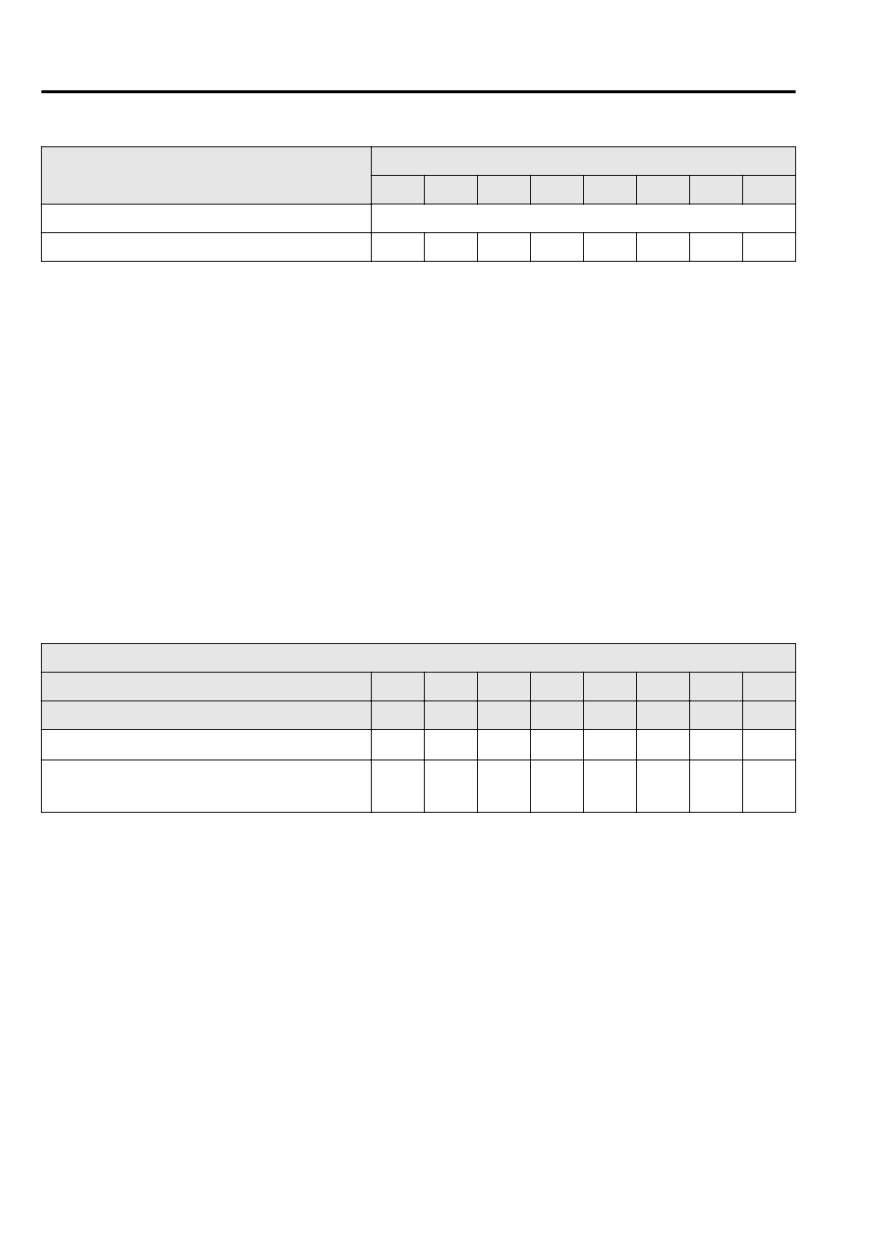
Maintenance and Care
Scheduled Maintenance
Number of times, maintenance was performed.
Maintenance Item
1
2
3
4
5
6
7
8
Cabin air filter
Replace every 40,000 km or 24 months.
Function of all lights
I
I
I
I
I
I
I
I
Chart symbols:
I: Inspect: Inspect and clean, repair, adjust, fill up, or replace if necessary.
R: Replace
T: Tighten
Remarks:
*1
Reset the engine oil data whenever replacing the engine oil regardless of the message/wrench
indicator light display.
*2
Use of FL-22 is recommended when replacing engine coolant. Using engine coolant other than FL-22
may cause serious damage to the engine and cooling system.
*3
According to state/provincial and federal regulations, failure to perform maintenance on these items
will not void your emissions warranties. However, Mazda recommends that all maintenance services
be performed at the recommended time or mileage/kilometer period to ensure long-term reliability.
*4
Inspect a spare tire if equipped.
Mexico Residents (Severe Driving Scheduled Maintenance):
Number of months or kilometers , whichever comes first.
Months
3
6
9
12
15
18
21
24
× 1000 km
5
10
15
20
25
30
35
40
Engine oil & filter*1
R
R
R
R
R
R
R
R
Maintenance Interval (other than engine oil
1st
2nd
3rd
4th
& filter replacement)*2
Chart symbols:
R: Replace
Remarks:
*1
Reset the engine oil data whenever replacing the engine oil regardless of the message/wrench
indicator light display.
*2
Follow Maintenance Interval listed in Normal Driving Scheduled Maintenance.
6-10
Maintenance and Care
Owner Maintenance
only by a qualified service technician
Owner Maintenance
with special tools.
Precautions
Improper owner maintenance during
▼ Owner Maintenance Precautions
the warranty period may affect
warranty coverage. Refer to
The owner or a qualified service
Introduction (page 6-2) for owner's
technician should make these vehicle
responsibility in protecting your
inspections at the indicated intervals to
investment. For details, read the
ensure safe and dependable
separate Mazda Warranty statement
operation.
provided with the vehicle. If you are
unsure about any servicing or
Bring any problem to the attention of
maintenance procedure, have it done
an Authorized Mazda Dealer or
by an Authorized Mazda Dealer.
qualified service technician as soon as
possible.
There are strict environmental laws
When Refueling
regarding the disposal of waste oil and
fluids. Please dispose of your waste
Brake fluid level (page 6-20)
properly and with due regard to the
Engine coolant level (page 6-19)
environment.
Engine oil level (page 6-18)
Washer fluid level (page 6-21)
We recommend that you entrust the oil
At Least Monthly
and fluid changes of your vehicle to an
Authorized Mazda Dealer.
Tire inflation pressures (page 6-31)
At Least Twice a Year (For Example,
WARNING
Every Spring and Fall)
Do not perform maintenance work if
You can do the following scheduled
you lack sufficient knowledge and
maintenance items if you have some
experience or the proper tools and
mechanical ability and a few basic
equipment to do the work. Have
tools and if you closely follow the
maintenance work done by a
directions in this manual.
qualified technician:
Engine coolant (page 6-19)
Performing maintenance work on a
Engine oil (page 6-18)
vehicle is dangerous if not done
properly. You can be seriously injured
while performing some maintenance
Improper or incomplete service may
procedures.
result in problems. This section gives
instructions only for items that are easy
to perform.
As explained in the Introduction (page
6-2), several procedures can be done
6-11
Maintenance and Care
Owner Maintenance
If you must run the engine while
Hood
working under the hood, make
certain that you remove all jewelry
▼ Hood
(especially rings, bracelets, watches,
and necklaces) and all neckties,
scarves, and similar loose clothing
WARNING
before getting near the engine or
cooling fan which may turn on
Always check that the hood is closed
unexpectedly:
and securely locked:
Working under the hood with the
A hood that is not closed and securely
engine running is dangerous. It
locked is dangerous as it could fly open
becomes even more dangerous when
while the vehicle is moving and block
you wear jewelry, loose clothing or
the driver's vision which could result in
have long hair or a long beard.
a serious accident.
Either can become entangled in
moving parts and result in injury.
Do not drive the vehicle with the
Hood-Ajar warning indication
displayed :
Otherwise, the Hood may open
Pull over to a safe location, then
unexpectedly and result in an accident.
switch the ignition off and make sure
▼ Opening the Hood
the fan is not running before
attempting to work near the cooling
1.
With the vehicle parked, pull the
fan:
release handle to unlock the hood.
Working near the cooling fan when it is
running is dangerous. The fan could
continue running indefinitely even if
the engine has stopped and the engine
compartment temperature is high. You
could be hit by the fan and seriously
injured.
Do not leave items in the engine
compartment:
After you have finished checking or
2.
Insert your hand into the hood
doing servicing in the engine
opening, slide the latch lever in the
compartment, do not forget and leave
direction of the arrow as shown in
items such as tools or rags in the
engine compartment.
Tools or other items left in the engine
compartment could cause engine
damage or a fire leading to an
unexpected accident.
6-12
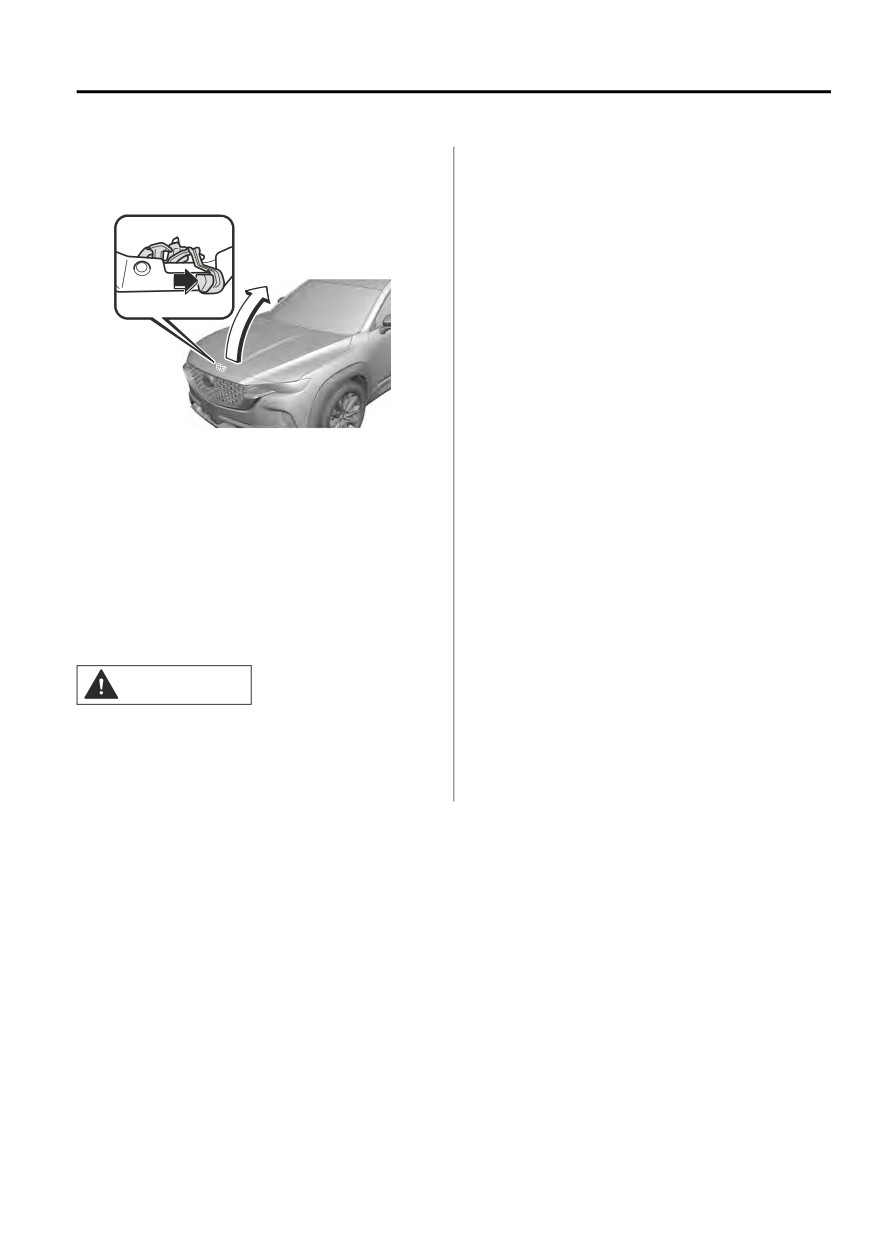
Maintenance and Care
Owner Maintenance
the illustration, and lift up the
hood.
▼ Closing the Hood
1. Check under the hood area to
make certain all filler caps are in
place and all loose items (e.g.
tools, oil containers, etc.) have
been removed.
2. Lower the hood slowly to a height
of about 20 cm (7.9 in) above its
closed position and then let it drop.
CAUTION
When closing the hood, do not push it
excessively such as by applying your
weight. Otherwise, the hood could be
deformed.
6-13

Maintenance and Care
Owner Maintenance
Engine Compartment Overview
▼ Engine Compartment Overview
SKYACTIV-G 2.5
1. Engine oil dipstick
2. Brake fluid reservoir
3. Battery
4. Fuse block
5. Cooling system cap
6. Engine oil-filler cap
7. Engine coolant reservoir
8. Windshield washer fluid reservoir
6-14
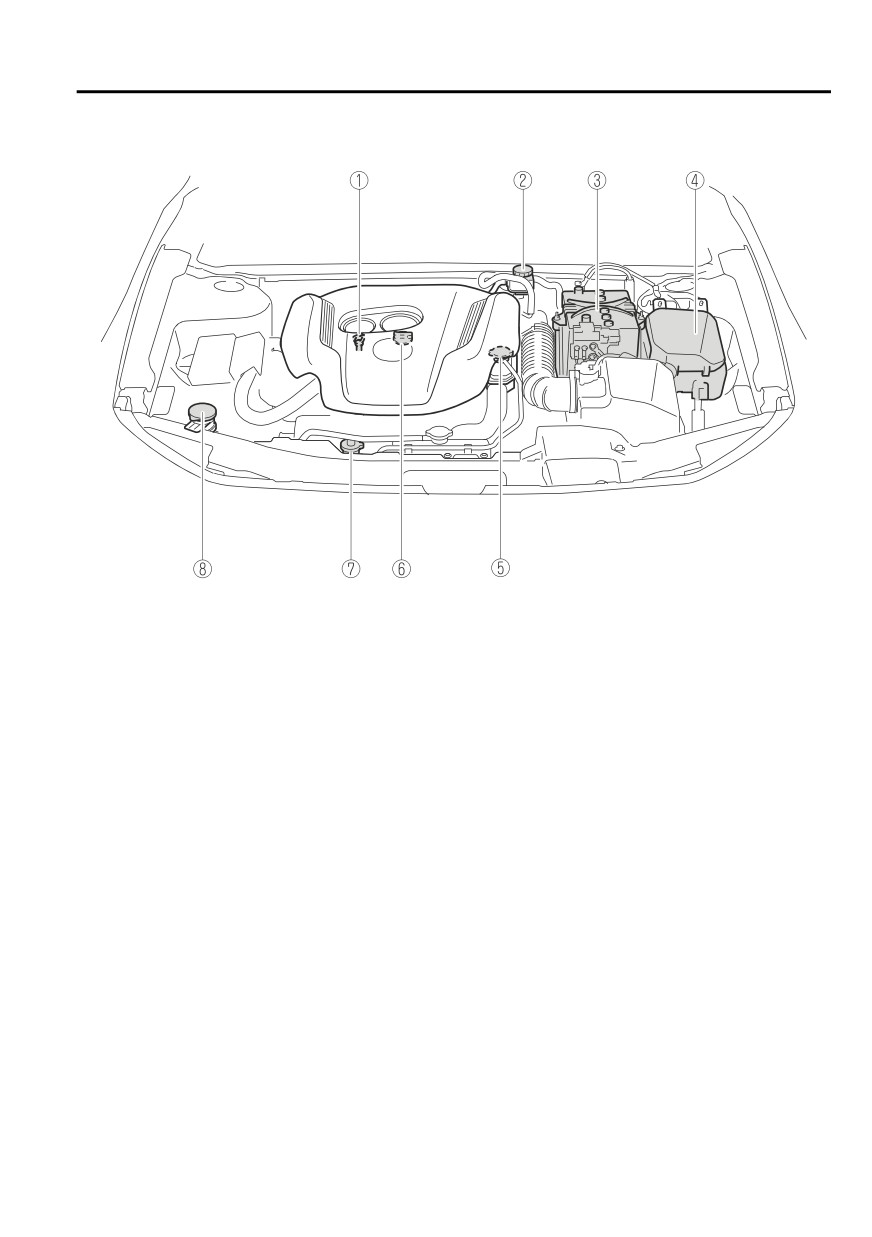
Maintenance and Care
Owner Maintenance
SKYACTIV-G 2.5T
1. Engine oil dipstick
2. Brake fluid reservoir
3. Battery
4. Fuse block
5. Cooling system cap
6. Engine oil-filler cap
7. Engine coolant reservoir
8. Windshield washer fluid reservoir
6-15
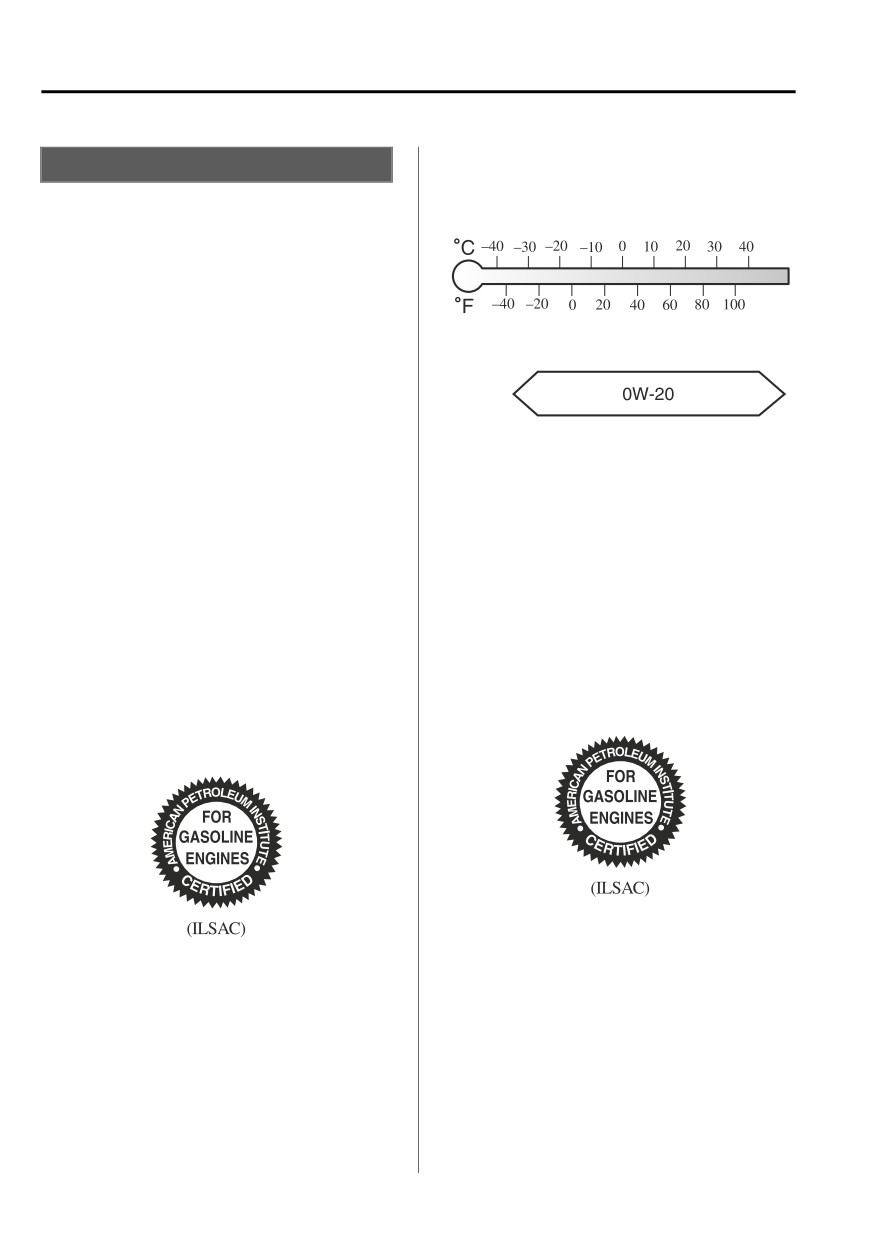
Maintenance and Care
Owner Maintenance
and Approval Committee (ILSAC),
Engine Oil
comprised of U.S. and Japanese
automobile manufacturers.
▼ Engine Oil
NOTE
Changing the engine oil should be
performed by an Authorized Mazda
Dealer.
Refer to Introduction on page 6-2 for
owner's responsibility in protecting
your investment.
▼ Recommended Oil
SKYACTIV-G 2.5T
U.S.A., Canada
Use SAE 5W-30 engine oil.
SKYACTIV-G 2.5
Mazda Genuine Oil is used in your
Use SAE 0W-20 engine oil.
Mazda vehicle. Mazda Genuine
Mazda Genuine Oil is used in your
5W-30 Oil is required to achieve
Mazda vehicle. Mazda Genuine
optimum fuel economy.
0W-20 Oil is required to achieve
optimum fuel economy.
For maintenance service, Mazda
recommends Genuine Mazda Parts
For maintenance service, Mazda
and Genuine Mazda Premium Oil.
recommends Genuine Mazda Parts
and Genuine Mazda Premium Oil.
Only use SAE 5W-30 oil “Certified For
Gasoline Engines” by the American
Only use SAE 0W-20 oil “Certified For
Petroleum Institute (API).
Gasoline Engines” by the American
Oil with this trademark symbol
Petroleum Institute (API).
conforms to the current engine and
Oil with this trademark symbol
emission system protection standards
conforms to the current engine and
and fuel economy requirements of the
emission system protection standards
International Lubricant Standardization
and fuel economy requirements of the
and Approval Committee (ILSAC),
International Lubricant Standardization
6-16

Maintenance and Care
Owner Maintenance
comprised of U.S. and Japanese
not available, use SAE 5W-20, SAE
automobile manufacturers.
0W-30 or SAE 10W-30 engine oil.
The quality designation SM, SN or SP
must be on the label.
Except U.S.A., Canada
Use SAE 5W-30 engine oil.
Oil container labels provide important
SKYACTIV-G 2.5T
information.
A chief contribution this type of oil
Use API SM or higher, SAE 5W-30
makes to fuel economy is reducing the
engine oil. If SAE 5W-30 engine oil is
amount of fuel necessary to overcome
not available, use SAE 0W-30 or SAE
engine friction.
10W-30 engine oil.
For maintenance service, Mazda
The quality designation SM, SN or SP
recommends Mazda Genuine Parts.
must be on the label.
(Mexico)
SKYACTIV-G 2.5
Use API SM or higher, SAE 5W-30
engine oil. If SAE 5W-30 engine oil is
6-17
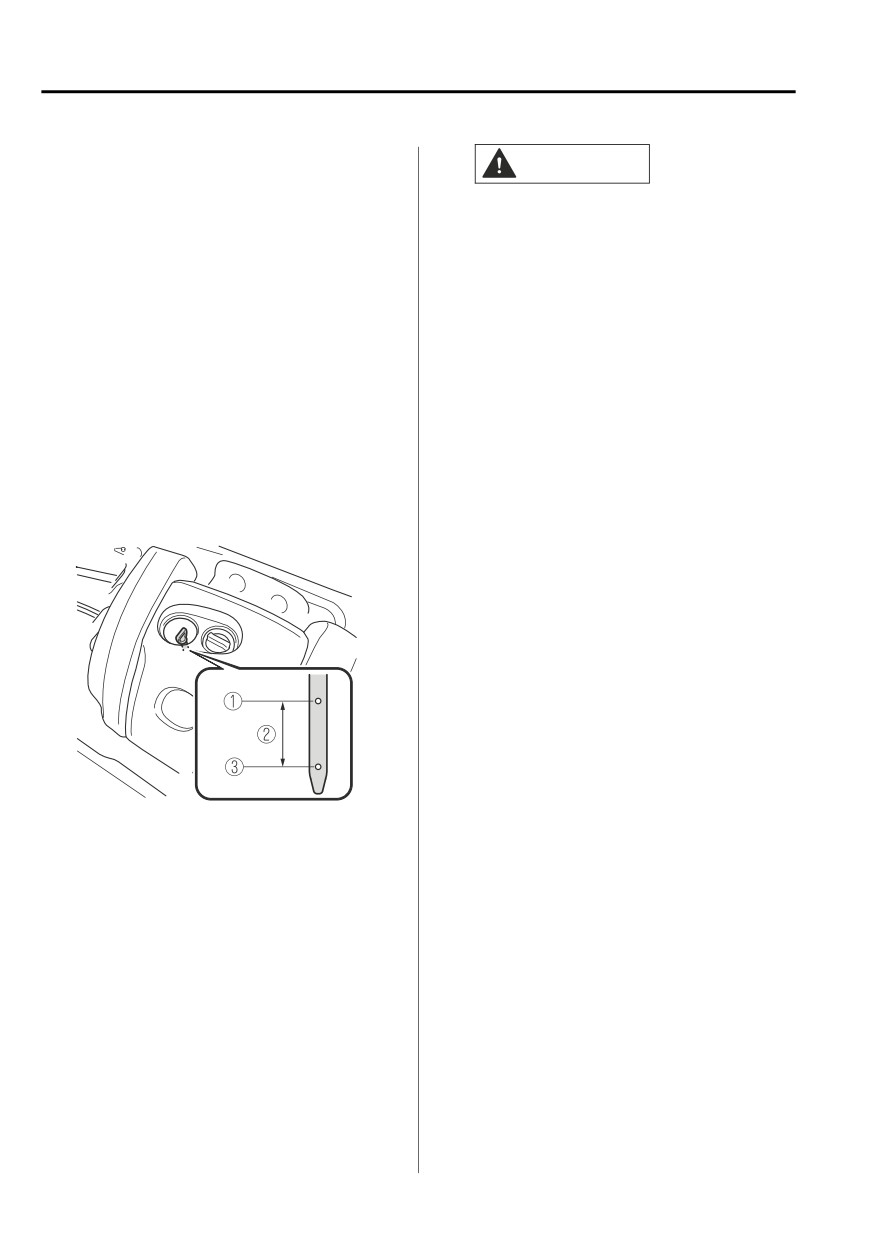
Maintenance and Care
Owner Maintenance
▼ Inspecting Engine Oil Level
CAUTION
NOTE
Do not overfill the engine oil. This
may cause engine damage.
If the engine oil level warning
6. Make sure the O-ring on the
indication/warning light turns on,
dipstick is positioned properly
add 1 L (0.26 US gal, 0.22 Imp gal)
before reinserting the dipstick.
of engine oil.
7. Reinsert the dipstick fully.
1. Be sure the vehicle is on a level
surface.
2. Warm up the engine to normal
operating temperature.
3. Turn it off and wait at least 5
minutes for the oil to return to the
oil pan.
4. Pull out the dipstick, wipe it clean,
and reinsert it fully.
1. MAX
2. OK
3. MIN
5. Pull it out again and examine the
level.
The level is normal if it is between
the MIN and MAX marks.
If it is near or below MIN, add
enough oil to bring the level to
MAX.
6-18
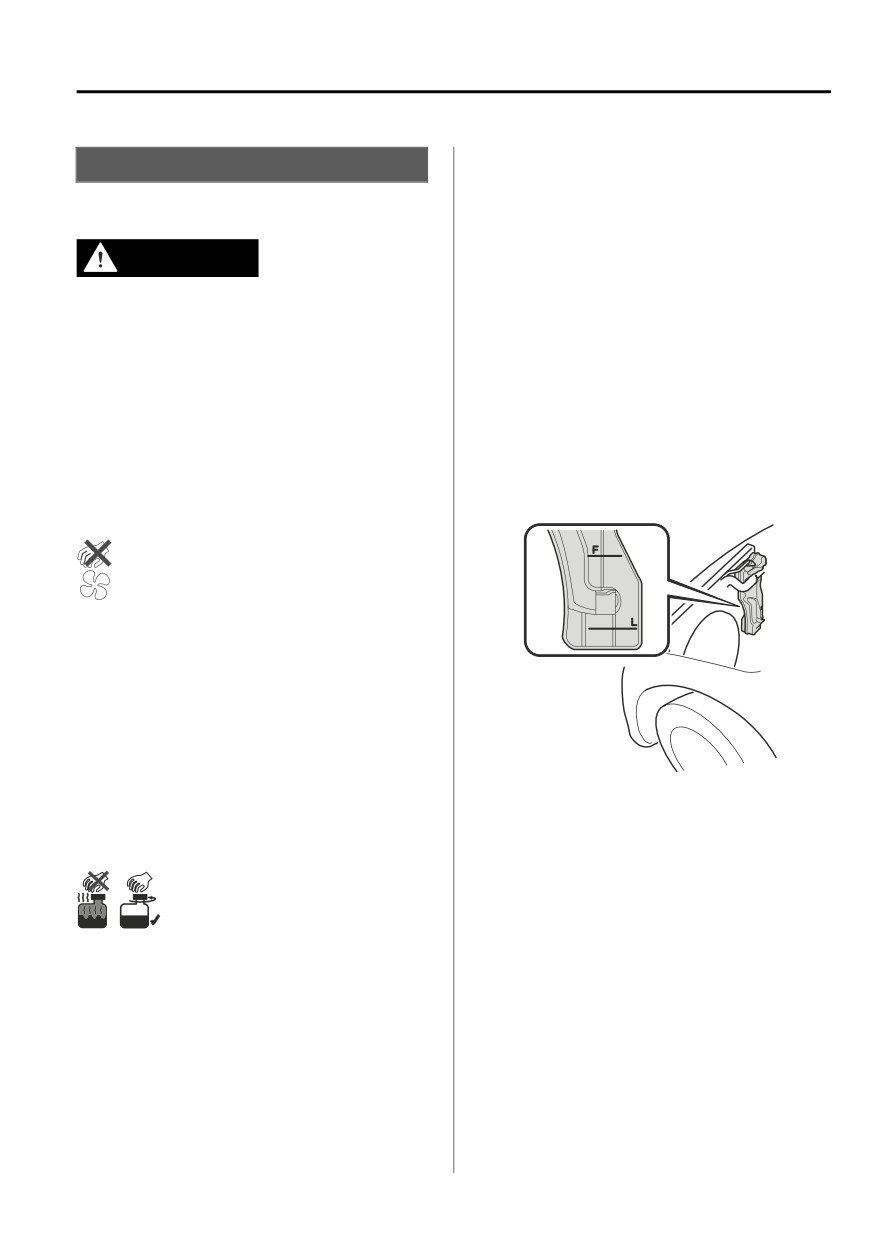
Maintenance and Care
Owner Maintenance
Inspect the antifreeze protection and
Engine Coolant
coolant level in the coolant reservoir at
least once a year―at the beginning of
▼ Inspecting Coolant Level
the winter season―and before
traveling where temperatures may drop
WARNING
below freezing.
Do not use a match or live flame in
Inspect the condition and connections
the engine compartment. DO NOT
of all cooling system and heater hoses.
ADD COOLANT WHEN THE ENGINE
Replace any that are swollen or
IS HOT:
deteriorated.
A hot engine is dangerous. If the
engine has been running, parts of the
The coolant should be at full in the
engine compartment can become very
radiator and between the F and L
hot. You could be burned. Carefully
marks on the coolant reservoir when
inspect the engine coolant in the
the engine is cool.
coolant reservoir, but do not open it.
Pull over to a safe location, then
switch the ignition off and make sure
the fan is not running before
attempting to work near the cooling
fan:
Working near the cooling fan when it is
running is dangerous. The fan could
continue running indefinitely even if
the engine has stopped and the engine
compartment temperature is high. You
If it is at or near L, add enough coolant
could be hit by the fan and seriously
to the coolant reservoir to provide
injured.
freezing and corrosion protection and
to bring the level to F.
Securely tighten the coolant reservoir
tank cap after adding coolant.
Do not remove either
cooling system cap when the engine
and radiator are hot:
When the engine and radiator are hot,
scalding coolant and steam may shoot
out under pressure and cause serious
injury.
NOTE
Changing the coolant should be done
by an Authorized Mazda Dealer.
6-19

Maintenance and Care
Owner Maintenance
CAUTION
Brake Fluid
¾ Radiator coolant will damage paint.
▼ Inspecting Brake Fluid Level
Rinse it off quickly if spilled.
¾ If the “FL22” mark is shown on or
WARNING
near the cooling system cap, use of
FL-22 is recommended when
If the brake fluid level is low, have the
replacing engine coolant. Using
brakes inspected:
engine coolant other than FL-22 may
A low brake fluid level is dangerous.
cause serious damage to the engine
A low level could indicate brake lining
and cooling system.
wear or a brake system leak which
could cause the brakes to fail and lead
to an accident.
Inspect the fluid level in the reservoir
regularly. It should be kept between
the MAX and MIN lines.
The level normally drops with
accumulated distance, a condition
If the coolant reservoir is empty or new
associated with wear of brake linings. If
coolant is required frequently, consult
it is excessively low, have the brake
an Authorized Mazda Dealer.
system inspected by an Authorized
Mazda Dealer.
6-20
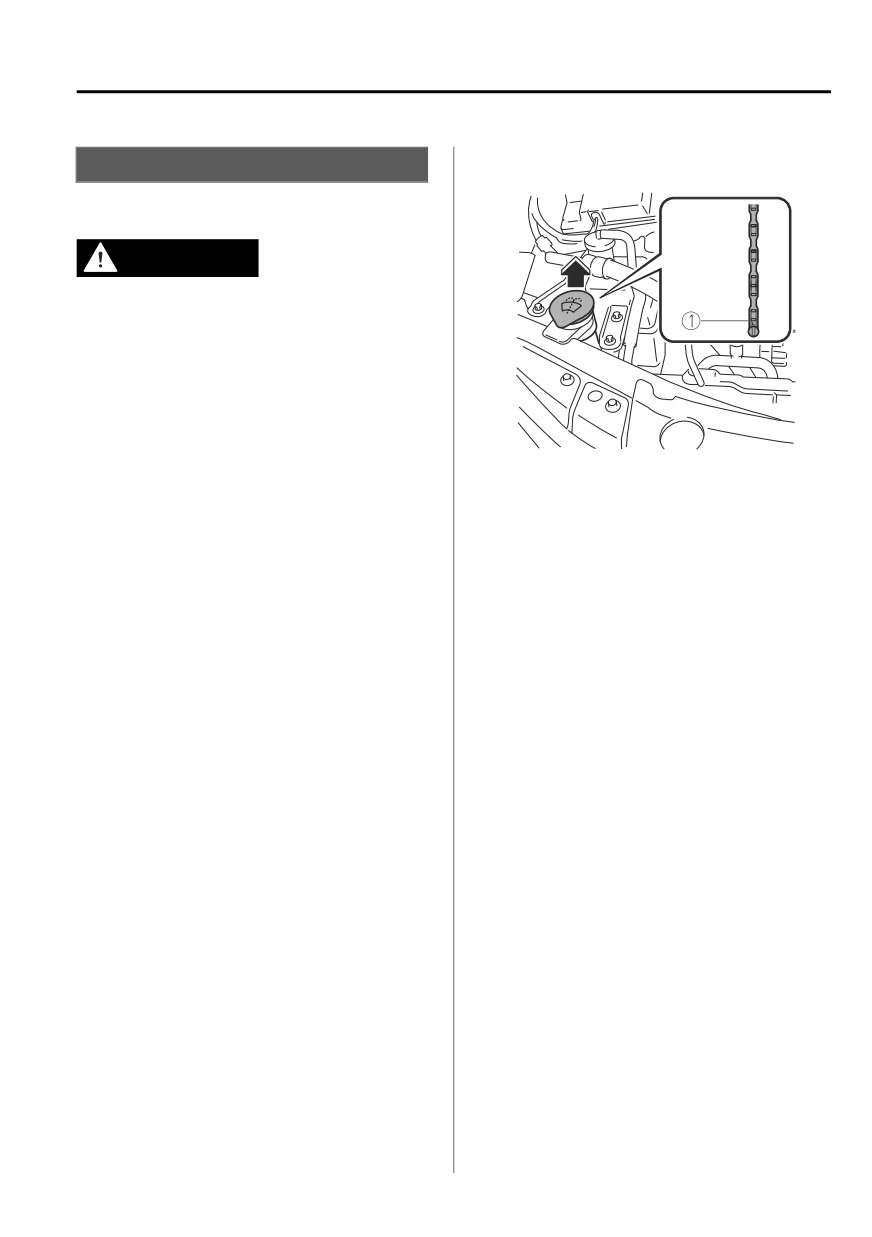
Maintenance and Care
Owner Maintenance
Inspect fluid level in the washer fluid
Washer Fluid
reservoir; add fluid if necessary.
▼ Inspecting Washer Fluid Level
WARNING
Use only windshield washer fluid or
plain water in the reservoir:
Using radiator antifreeze as washer
fluid is dangerous. If sprayed on the
windshield, it will dirty the windshield,
affect your visibility, and could result in
an accident.
1. L
Using Washer Fluid Without
Anti-freeze Protection in Cold
Use plain water if washer fluid is
Weather:
unavailable.
Operating your vehicle in temperatures
But use only washer fluid in cold
below 4 °C (40 °F) using washer fluid
weather to prevent it from freezing.
without anti-freeze protection is
NOTE
dangerous as it could cause impaired
windshield vision and result in an
Front and rear washer fluid is supplied
from the same reservoir.
accident. In cold weather, always use
washer fluid with anti-freeze
protection.
NOTE
State or local regulations may restrict
the use of volatile organic compounds
(VOCs), which are commonly used as
anti-freeze agents in washer fluid. A
washer fluid with limited VOC content
should be used only if it provides
adequate freeze resistance for all
regions and climates in which the
vehicle will be operated.
6-21
Maintenance and Care
Owner Maintenance
Body Lubrication
Wiper Blades
▼ Body Lubrication
▼ Wiper Blades
All moving points of the body, such as
door and hood hinges and locks,
CAUTION
should be lubricated each time the
¾ Hot waxes applied by automatic car
engine oil is changed. Use a
washers have been known to affect
non-freezing lubricant on locks during
the wiper's ability to clean windows.
cold weather.
¾ An operation malfunction may occur
or the wiper effectiveness may be
Make sure the hood's secondary latch
reduced if a water-repellent coating
keeps the hood from opening when
is used.
the primary latch is released.
¾ To prevent damage to the wiper
blades, do not use gasoline,
kerosene, paint thinner, or other
solvents on or near them.
¾ When the wiper lever is in the AUTO
position and the ignition is switched
ON, the wipers may move
automatically in the following cases:
¾ If the windshield above the rain
sensor is touched.
¾ If the windshield above the rain
sensor is wiped with a cloth.
¾ If the windshield is struck with a
hand or other object.
¾ If the rain sensor is struck with a
hand or other object from inside
the vehicle.
Be careful not to pinch hands or
fingers as it may cause injury, or
damage the wipers. When washing
or servicing the vehicle, make sure
the wiper lever is in the OFF
position.
¾ Before lifting the windshield wiper
blades off the windshield, always
follow the procedure for moving the
windshield wiper blades. Otherwise,
a wiper blade, wiper arm, or the
hood could be damaged.
6-22
Maintenance and Care
Owner Maintenance
Refer to the Replacing Windshield
¾ To prevent damage to the wiper
Wiper Blades (page 6-23) section
arms and other components, do not
for the procedure on how to move
try to sweep the wiper arm by hand.
the windshield wiper blades to the
¾ Do not bend the blade rubber
service position.
unnecessarily when replacing it.
Otherwise, the metal stiffener in the
Contamination of either the
blade may deform and the
windshield or the blades with foreign
windshield wiper operation may be
matter can reduce wiper effectiveness.
adversely affected.
Common sources are insects, tree sap,
¾ Do not hold a wiper blade by its end
and hot wax treatments used by some
when raising the wiper arm.
commercial car washes.
Otherwise, the part may deform and
If the blades are not wiping properly,
the wiping performance may lower.
clean the window and blades with a
¾ Forcefully lowering the wiper arms
good cleaner or mild detergent; then
could damage the wiper arm and
rinse thoroughly with clean water.
blade, and may scratch or crack the
Repeat if necessary.
windshield.
▼ Replacing Windshield Wiper
Blades
NOTE
You can replace the wiper blades
When the wipers no longer clean well,
yourself, however you cannot replace
the blades are probably worn or
the wiper arms.
cracked.
If you want to replace the wiper arms,
Replace them.
consult an Authorized Mazda Dealer.
CAUTION
Replace the wiper blades using the
following procedure.
¾ To prevent damaging a windshield
1. Move the wipers to the service
wiper blade, wiper arm, or the hood,
positions using the following
perform the following procedure.
procedure.
¾ Before lifting the windshield wiper
a) Switch the ignition ON.
blades off the windshield, always
b) Switch the ignition OFF.
move them to the service position.
c) Press up the wiper switch to the
¾ When putting the windshield
MIST position 2 times within 30
wiper blades back on the
seconds after switching the
windshield, make sure that they
ignition OFF.
are in the service position before
When the procedure is
switching the ignition ON and
completed, the wipers operate
operating the windshield wipers.
and they stop at the service
¾ Replace with Mazda genuine wiper
positions.
2. Raise the wiper arms.
blades. If they are replaced with
wiper blades other than a Mazda
3. Slide the blade component in the
direction of the arrow while
genuine product, they may not wipe
with the same efficiency as the
pressing the wiper arm tab to
genuine product.
6-23
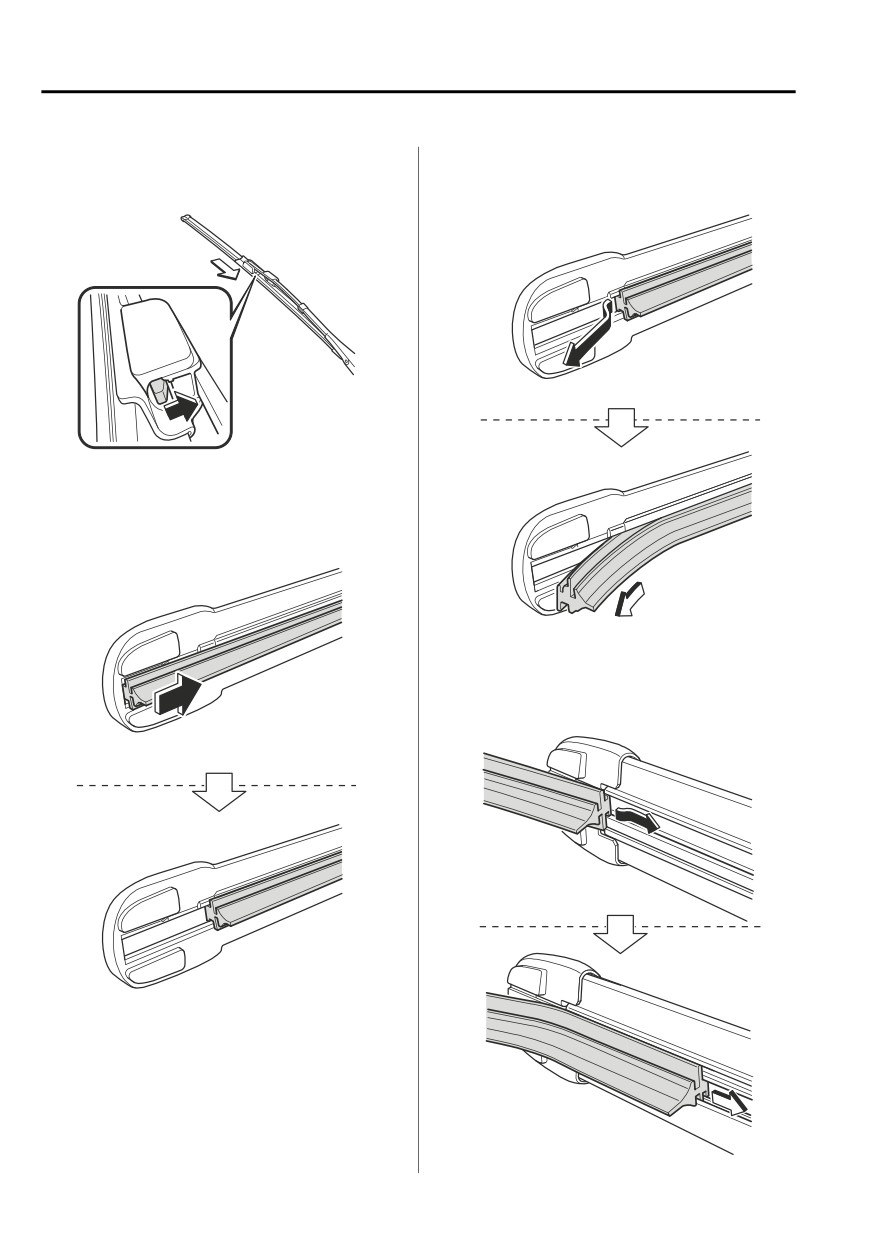
Maintenance and Care
Owner Maintenance
remove the blade component from
the blade rubber from the blade
the wiper arm.
holder.
4. Pull the blade rubber in the
direction of the arrow and slide it
to a position where the blade
holder groove can be checked.
6. Insert the end of the new blade
rubber into the groove of the blade
holder until it contacts the end of
the blade holder.
5. Pull the end of the blade rubber
from the blade holder groove in the
direction of the arrow and remove
6-24

Maintenance and Care
Owner Maintenance
7.
After pulling the blade rubber in the
CAUTION
direction of the arrow and sliding
the blade rubber to a position to
To prevent damage to the
check the blade holder groove,
windshield let the wiper arm down
slide the blade rubber end in the
easily, do not let it slap down on
opposite direction.
the windshield.
11.Move the wipers to their initial
positions using the following
procedure.
a) Make sure that the wipers are set
on the windshield.
b) Switch the ignition ON.
c) Press up the wiper switch to the
MIST position 1 time.
When the procedure is
completed, the wipers operate
and they stop at the initial
positions.
▼ Replacing Rear Window Wiper
Blade
When the wiper no longer cleans well,
the blade is probably worn or cracked.
Replace it.
CAUTION
8.
Make sure that the blade rubber is
To prevent damage to the wiper arm
correctly installed to the blade
and other components, do not move
holder.
the wiper by hand.
9.
Slide the blade component and
1. Remove the cover.
install it to the wiper arm.
10.Slowly lower the wiper arms onto
the windshield.
6-25
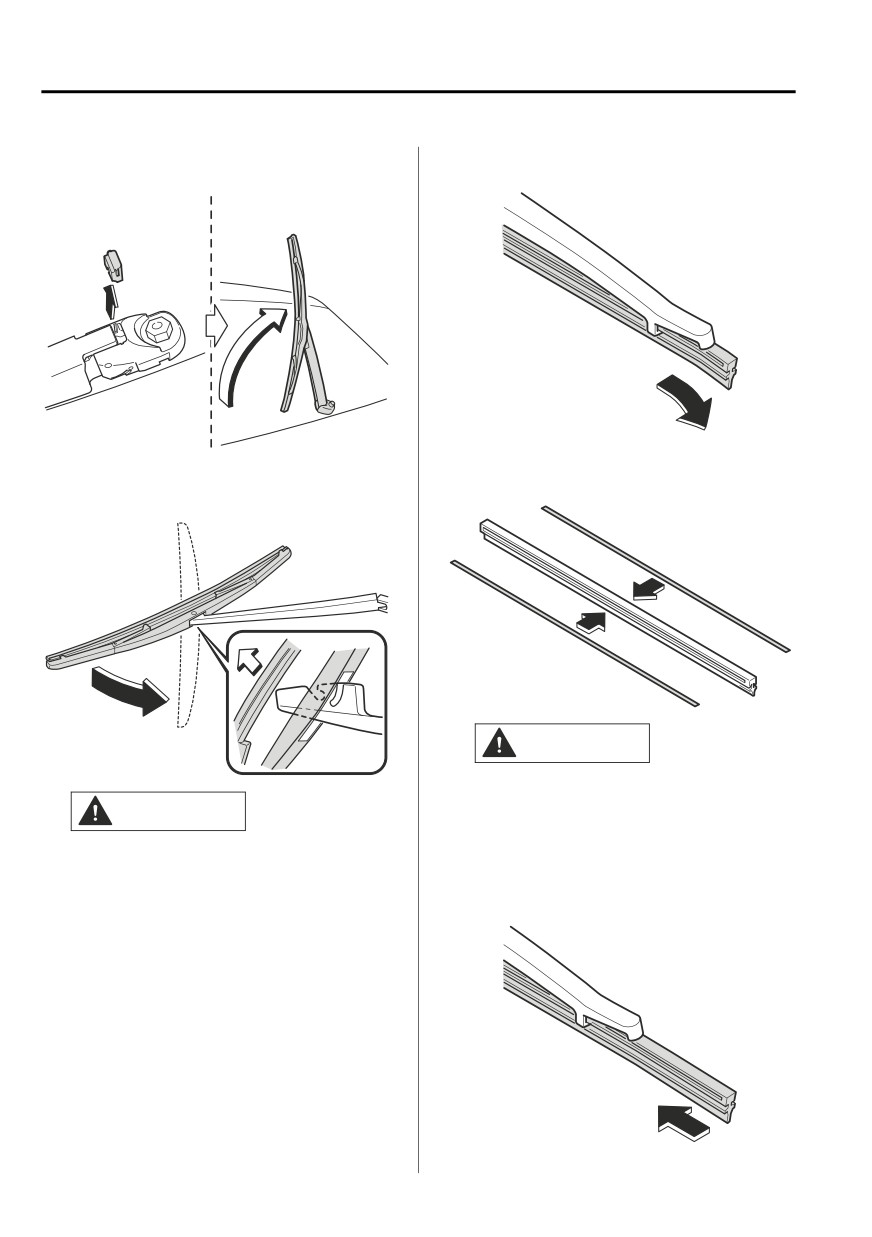
Maintenance and Care
Owner Maintenance
2. Remove the stopper and raise the
4. Pull down the blade rubber and
wiper arm.
slide it out of the blade holder.
5. Remove the metal stiffeners from
3. Firmly rotate the wiper blade to the
the blade rubber and install them in
right until it unlocks, then remove
the new blade.
the blade.
CAUTION
Do not bend or discard the
stiffeners. You need to use them
CAUTION
again.
To prevent damage to the rear
6. Carefully insert the new blade
window, do not let the wiper arm
rubber.
fall on it.
Then install the blade assembly in
the reverse order of removal.
6-26

Maintenance and Care
Owner Maintenance
Battery fluid contains SULFURIC ACID
Battery
which could cause serious injuries if it
gets in eyes, or on the skin or clothing.
▼ Battery
If this happens, immediately flush your
eyes with water for 15 minutes or wash
WARNING
your skin thoroughly and get medical
attention.
Wash hands after handling the battery
and related accessories:
Battery posts, terminals and related
accessories contain lead and lead
Always keep batteries out of
compounds, chemicals known to the
the reach of children:
State of California to cause cancer and
Allowing children to play near batteries
reproductive harm.
is dangerous. Battery fluid could cause
serious injuries if it gets in the eyes or
on the skin.
Read the following precautions
carefully before using the battery or
inspecting to ensure safe and correct
Keep flames and sparks away
handling:
from open battery cells and do not
allow metal tools to contact the
positive (+) or negative (-) terminal of
the battery when working near a
Always wear eye protection
battery. Do not allow the positive (+)
when working near the battery:
terminal to contact the vehicle body:
Working without eye protection is
Flames and sparks near open battery
dangerous. Battery fluid contains
cells are dangerous. Hydrogen gas,
SULFURIC ACID which could cause
produced during normal battery
blindness if splashed into your eyes.
operation, could ignite and cause the
Also, hydrogen gas produced during
battery to explode. An exploding
normal battery operation, could ignite
battery can cause serious burns and
and cause the battery to explode.
injuries. Keep all flames including
cigarettes and sparks away from open
battery cells.
Wear eye protection and
protective gloves to prevent contact
with battery fluid:
Spilled battery fluid is dangerous.
6-27
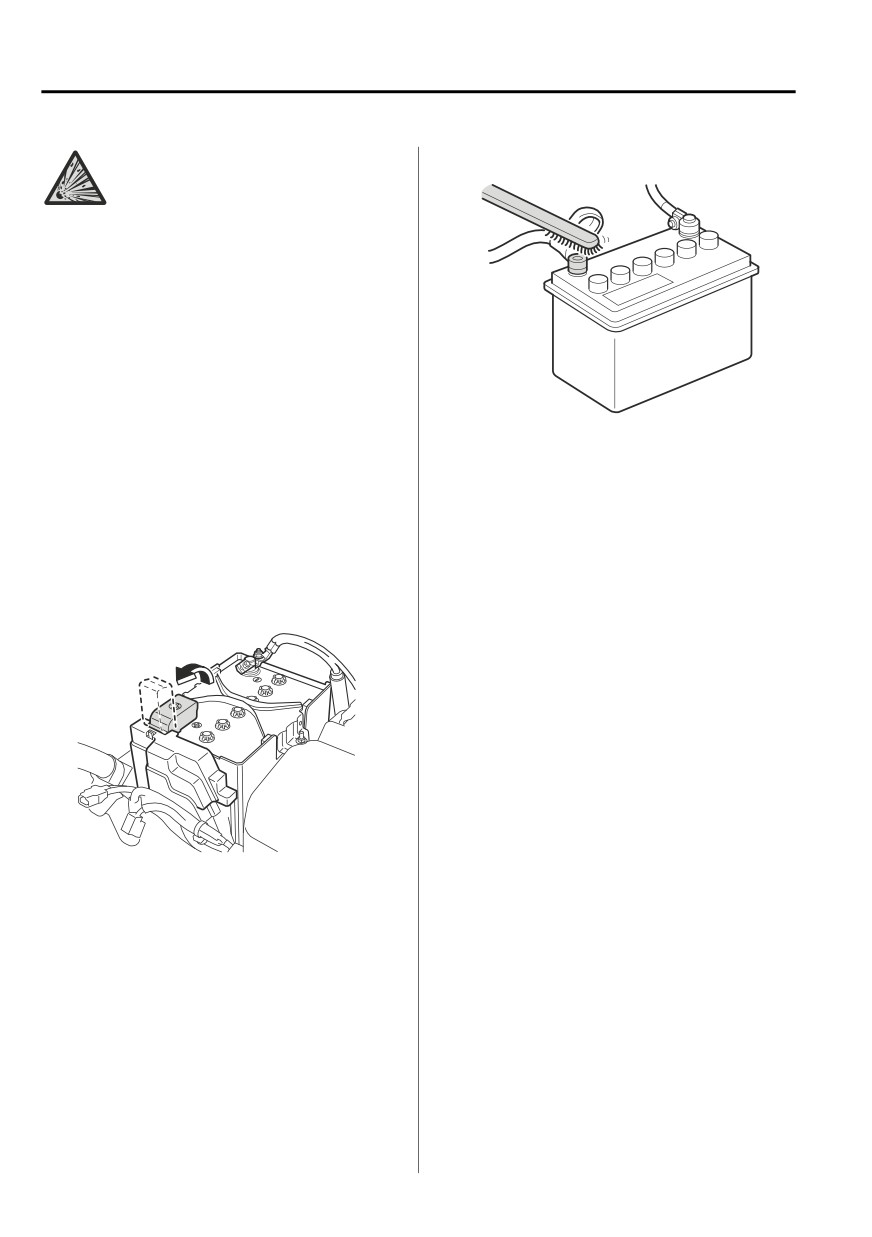
Maintenance and Care
Owner Maintenance
▼ Battery Maintenance
Keep all flames and sparks
away from open battery cells because
hydrogen gas is produced from open
battery cells while charging the
battery or adding battery fluid:
Flames and sparks near open battery
cells are dangerous. Hydrogen gas,
produced during normal battery
operation, could ignite and cause the
battery to explode. An exploding
battery can cause serious burns and
To get the best service from a battery:
injuries. Keep all flames including
cigarettes and sparks away from open
Keep it securely mounted.
battery cells.
Keep the top clean and dry.
Keep terminals and connections
NOTE
clean, tight, and coated with
Before performing battery
petroleum jelly or terminal grease.
maintenance, remove the battery
Rinse off spilled electrolyte
cover.
immediately with a solution of water
and baking soda.
If the vehicle will not be used for an
extended time, disconnect the
battery cables and charge the battery
every 6 weeks.
▼ Battery Replacement
Contact an Authorized Mazda Dealer
for battery replacement.
6-28

Maintenance and Care
Owner Maintenance
transmitter does not flash when the
Key Battery Replacement
buttons are pressed.
The system's operational range is
▼ Key Battery Replacement
reduced.
If the buttons on the transmitter are
Incorrect battery replacement
inoperable and the operation indicator
operation may damage the key.
light does not flash, the battery may be
Replacing the battery at an Authorized
dead.
Mazda Dealer is recommended. If
Replace with a new battery before the
replacing the battery by yourself,
transmitter becomes unusable.
follow the instruction.
CAUTION
Replacing the key battery
¾ Make sure the battery is installed
1.
Remove the lower cover while
correctly. Battery leakage could occur
sliding the knob in the direction of
if it is not installed correctly.
the arrow.
¾ When replacing the battery, be
careful not to touch any of the
internal circuitry and electrical
terminals, bend the electrical
terminals, or get dirt in the
transmitter as the transmitter could
be damaged.
¾ There is the danger of explosion if
the battery is not correctly replaced.
2.
Press in the tab to unlock the upper
¾ Dispose of used batteries according
cover.
to the following instructions.
¾ Insulate the plus and minus
terminals of the battery using
cellophane or equivalent tape.
¾ Never disassemble.
¾ Never throw the battery into fire or
water.
¾ Never deform or crush.
¾ Replace only with the same type
battery (CR2032 or equivalent).
The following conditions indicate that
the battery power is low:
A message, “Low Key Fob Battery.
Replace Battery” is displayed on the
multi-information display when the
ignition is switched OFF.
The system does not operate and the
operation indicator light on the
6-29
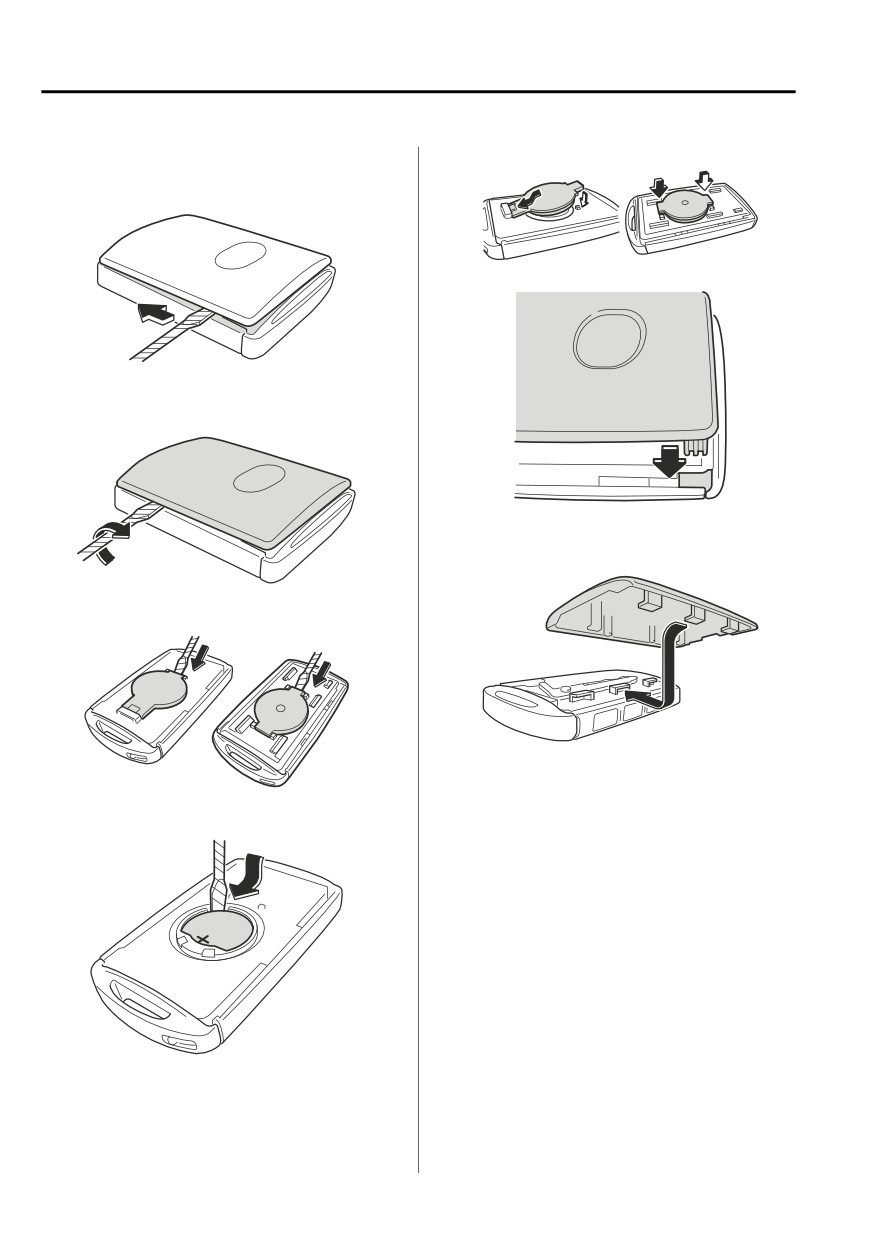
Maintenance and Care
Owner Maintenance
3. Insert a tape-wrapped flathead
8. Install the cap.
screwdriver into the gap and slide it
in the direction of the arrow.
9. Install the upper cover.
4. Twist the flathead screwdriver in the
direction of the arrow and remove
the upper cover.
10.Insert the tabs of the lower cover
into the slots of the transmitter and
install the lower cover.
5. Remove the cap using the
tape-wrapped flathead screwdriver.
6. Remove the battery using
tape-wrapped flathead screwdriver.
7. Insert a new battery into the
transmitter so that the positive pole
is facing up.
6-30
Maintenance and Care
Owner Maintenance
Use only a Mazda-genuine tire valve
Tires
cap:
Use of a non-genuine part is
▼ Tires
dangerous as the correct tire air
For reasons of proper performance,
pressure cannot be maintained if the
safety, and better fuel economy, always
tire valve becomes damaged. If the
maintain recommended tire inflation
vehicle is driven under this condition,
pressures and stay within the
the tire air pressure will decrease
recommended load limits and weight
which could result in a serious
distribution.
accident. Do not use any part for the
tire valve cap that is not a
WARNING
Mazda-genuine part.
Inspect all tire pressures monthly
Using Different Tire Types:
(including the spare) when the tires are
Driving your vehicle with different
cold. Maintain recommended
types of tires is dangerous. It could
pressures for the best ride, handling,
cause poor handling and poor braking;
and minimum tire wear.
leading to loss of control.
Refer to the specification charts (page
Except for the limited use of the
9-7).
temporary spare tire, use only the
same type tires (radial, bias-belted,
NOTE
bias-type) on all four wheels.
Always check tire pressure when tires
are cold.
Using Wrong-Sized Tires:
Warm tires normally exceed
Using any other tire size than what is
recommended pressures. Do not
specified for the vehicle (page 9-7)
release air from warm tires to adjust
is dangerous. It could seriously affect
the pressure.
ride, handling, ground clearance, tire
Underinflation can cause reduced
clearance, and speedometer
fuel economy, uneven and
calibration. This could cause you to
accelerated tire wear, and poor
have an accident. Use only tires that
sealing of the tire bead, which will
are the correct size specified for the
deform the wheel and cause
vehicle.
separation of tire from rim.
▼ Tire Inflation Pressure
Overinflation can produce a harsh
ride, uneven and accelerated tire
wear, and a greater possibility of
WARNING
damage from road hazards.
Keep your tire pressure at the correct
Always inflate the tires to the correct
levels. If one frequently needs
pressure:
inflating, have it inspected.
Overinflation or underinflation of tires
is dangerous. Adverse handling or
unexpected tire failure could result in a
serious accident.
Refer to Tires on page 9-7.
6-31
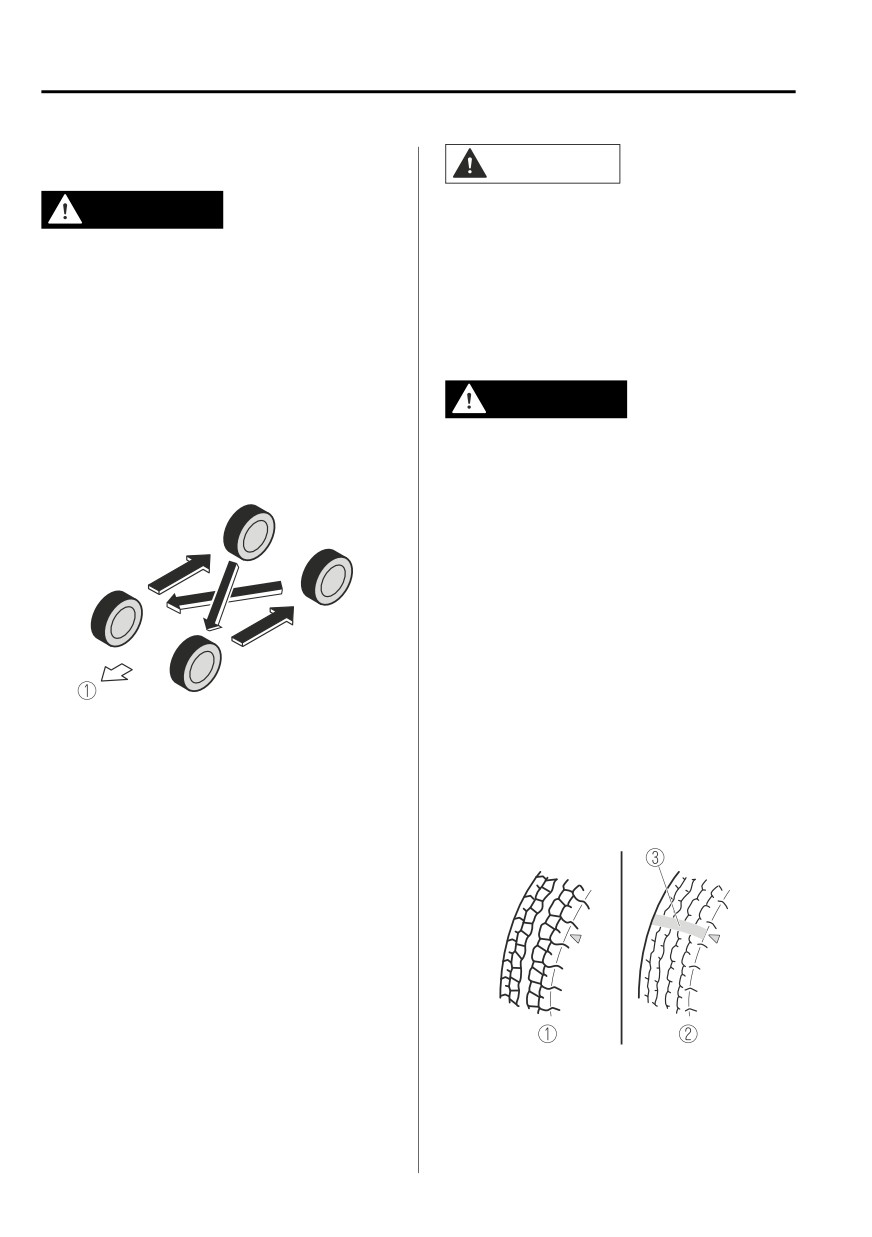
Maintenance and Care
Owner Maintenance
▼ Tire Rotation
CAUTION
Rotate unidirectional tires and radial
WARNING
tires that have an asymmetrical tread
pattern or studs only from front to rear,
Rotate tires periodically:
not from side to side. Tire performance
Irregular tire wear is dangerous. To
will be reduced if rotated from side to
equalize tread wear for maintaining
side.
good performance in handling and
braking, rotate the tires periodically or
▼ Replacing a Tire
sooner if irregular wear develops.
Please refer to Scheduled maintenance
WARNING
for your tire rotation interval.
During rotation, inspect them for
Always use tires that are in good
correct balance.
condition:
Driving with worn tires is dangerous.
Reduced braking, steering, and
traction could result in an accident.
Replace all four tires at the same
time:
Replacing just one tire is dangerous. It
could cause poor handling and poor
braking resulting in loss of vehicle
control. Mazda strongly recommends
1. Forward
that you replace all four tires at the
Do not include (TEMPORARY USE
same time.
ONLY) spare tire in rotation.
If a tire wears evenly, a wear indicator
will appear as a solid band across the
Also, inspect them for uneven wear
tread.
and damage. Abnormal wear is usually
Replace the tire when this happens.
caused by one or a combination of the
following:
Incorrect tire pressure
Improper wheel alignment
Out-of-balance wheel
Severe braking
After rotation, inflate all tire pressures
to specification on page 9-7 and
inspect the lug nuts for tightness.
1. New tread
2. Worn tread
6-32
Maintenance and Care
Owner Maintenance
3. Tread wear indicator
CAUTION
You should replace the tire before the
¾ Do not use your temporary spare tire
band crosses the entire tread.
rim with a snow tire or a
conventional tire. Neither will
NOTE
properly fit and could damage both
Tires degrade over time, even when
tire and rim.
they are not being used on the road. It
¾ The temporary spare tire has a tread
is recommended that tires generally be
life of less than 5,000 km (3,000
replaced when they are 6 years or
miles). The tread life may be shorter
older. Heat caused by hot climates or
depending on driving conditions.
frequent high loading conditions can
¾ The temporary spare tire is for
accelerate the aging process. The
limited use, however, if the tread
period in which the tire was
wear solid-band indicator appears,
manufactured (both week and year) is
replace the tire with the same type of
indicated by a 4-digit number.
temporary spare (page 6-32).
Refer to Tire Labeling on page 8-22.
▼ Temporary Spare Tire
NOTE
Tires degrade over time, even when
Inspect the temporary spare tire at
they are not being used on the road. It
least monthly to make sure it is
is recommended that tires generally be
properly inflated and stored.
replaced when they are 6 years or
NOTE
older. Heat caused by hot climates or
The temporary spare tire condition
frequent high loading conditions can
gradually deteriorates even if it has not
accelerate the aging process. The
been used.
period in which the tire was
manufactured (both week and year) is
The temporary spare tire is easier to
indicated by a 4-digit number.
handle because of its construction
Refer to Tire Labeling on page 8-22.
which is lighter and smaller than a
conventional tire. This tire should be
used only for an emergency and only
for a short distance.
Use the temporary spare tire only until
the conventional tire is repaired, which
should be as soon as possible.
Refer to Tires on page 9-7.
6-33
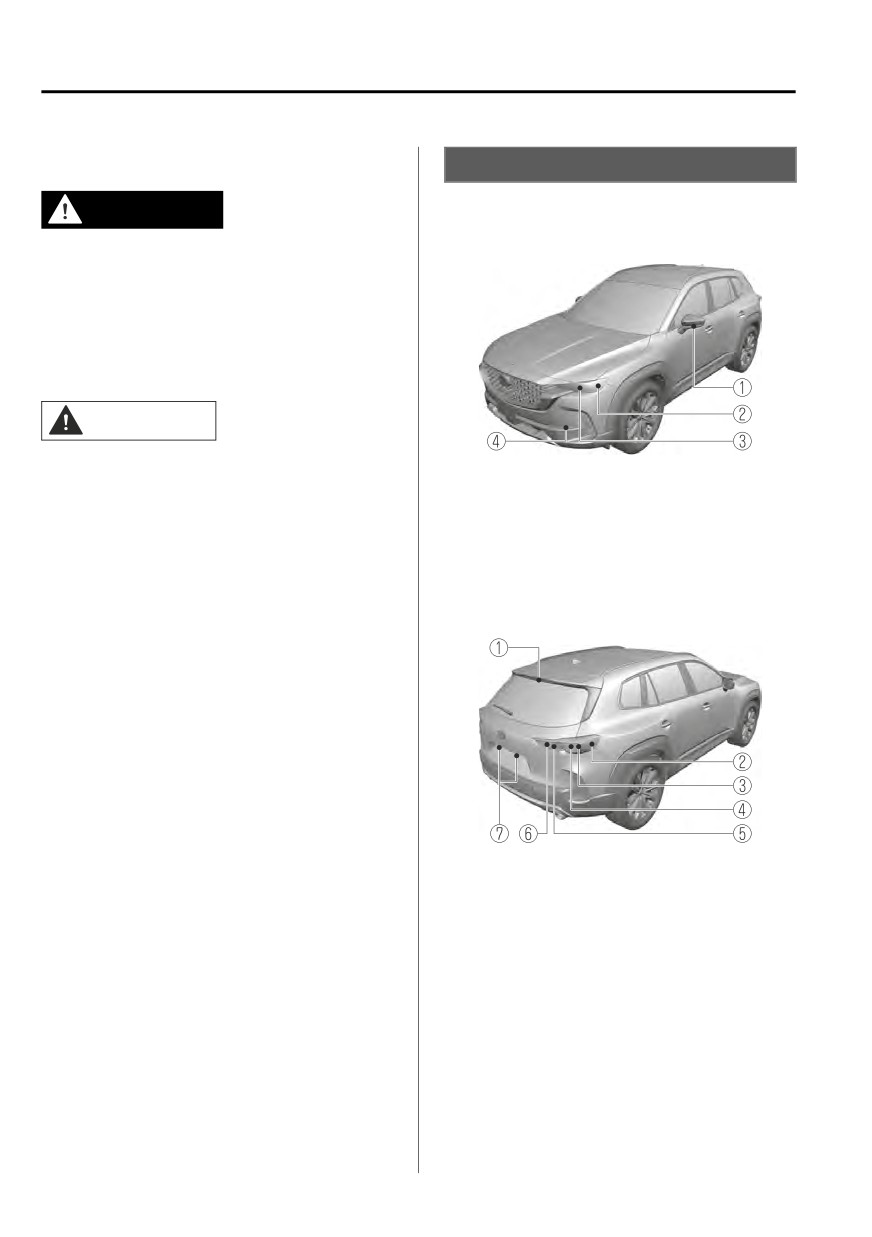
Maintenance and Care
Owner Maintenance
▼ Replacing a Wheel
Light Bulbs
▼ Light Bulbs
WARNING
Front
Always use wheels of the correct size
on your vehicle:
Using a wrong-sized wheel is
dangerous. Braking and handling could
be affected, leading to loss of control
and an accident.
CAUTION
A wrong-sized wheel may adversely
1. Side turn signal lights*
affect:
2. Front side-marker lights
¾ Tire fit
3. Headlights (High/Low beam)/
¾ Wheel and bearing life
Daytime running lights
¾ Ground clearance
4. Front turn signal lights/Parking
¾ Snow-chain clearance
lights
¾ Speedometer calibration
Rear
¾ Headlight aim
¾ Bumper height
¾ Tire Pressure Monitoring System
NOTE
When replacing a wheel, make sure
the new one is the same as the
original factory wheel in diameter,
rim width, and offset (inset/outset).
For details, contact an Authorized
Mazda Dealer.
1. High-mount brake light
2. Rear side-marker lights
3. Brake lights/Taillights
Proper tire balancing provides the best
4. Rear turn signal lights
riding comfort and helps reduce tread
5. Taillights*
wear. Out-of-balance tires can cause
6. Reverse lights
vibration and uneven wear, such as
7. License plate lights
cupping and flat spots.
6-34
*Some models.

Maintenance and Care
Owner Maintenance
▼ Replacing Light Bulbs
Fuses
All the light bulbs are the LED type.
▼ Fuses
The LED bulb cannot be replaced as a
single unit because it is an integrated
Your vehicle's electrical system is
unit.
protected by fuses.
The LED bulb has to be replaced with
the unit. If a replacement is necessary,
If any lights, accessories, or controls do
consult an Authorized Mazda Dealer.
not work, inspect the appropriate
circuit protector. If a fuse has blown,
Adjusting the Headlight Aim
the inside element will be melted.
If the headlight cannot be adjusted
using procedure below, consult an
If the same fuse blows again, avoid
Authorized Mazda Dealer.
using that system and consult an
1. Make sure the vehicle has a full
Authorized Mazda Dealer as soon as
tank of gasoline and the area
possible.
around the headlight is not
deformed.
▼ Fuse Replacement
2. Park the vehicle on level ground.
Replacing the fuses on the vehicle's
3. Sit in the driver's seat.
left side
4. Bounce the vehicle several times.
5. Using a Phillips-head screw-driver,
If the electrical system does not work,
turn bolt A in either direction.
first inspect the fuses on the vehicle's
Remember the turning direction
left side.
and the number of turns.
6. Turn bolt B the same number of
1. Make sure the ignition is switched
turns and in the same direction as
off, and other switches are off.
step 5.
2. Open the fuse panel cover.
1. Adjustment bolt A
2. Adjustment bolt B
6-35
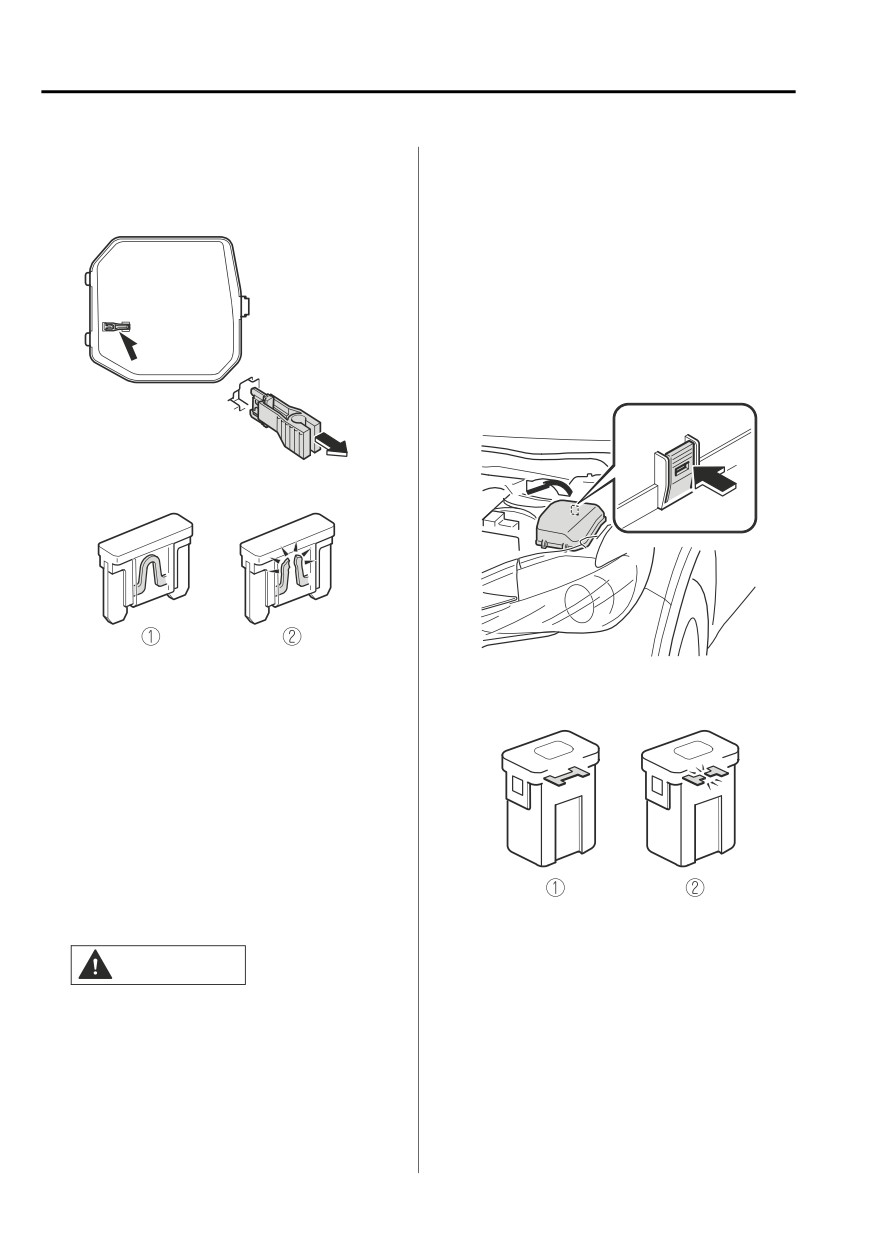
Maintenance and Care
Owner Maintenance
3. Pull the fuse straight out with the
Replacing the fuses under the hood
fuse puller provided on the fuse
If the headlights or other electrical
block located in the engine
components do not work and the fuses
compartment.
in the cabin are normal, inspect the
fuse block under the hood.
If a fuse is blown, it must be replaced.
Follow these steps:
1. Make sure the ignition is switched
off, and other switches are off.
2. Remove the fuse block cover.
4. Inspect the fuse and replace it if it is
blown.
1. Normal
3.
If any fuse but the MAIN fuse is
2. Blown
blown, replace it with a new one of
the same amperage rating.
5.
Insert a new fuse of the same
amperage rating, and make sure it
fits tightly. If it does not fit tightly,
have an expert install it. Consult an
Authorized Mazda Dealer.
If you have no spare fuses, borrow
one of the same rating from a
circuit not essential to vehicle
operation, such as the audio or
1. Normal
accessory socket circuit.
2. Blown
CAUTION
Always replace a fuse with a
genuine Mazda fuse or equivalent
of the same rating. Otherwise, you
may damage the electric system.
6.
Reinstall the cover and make sure
that it is securely installed.
6-36
Maintenance and Care
Owner Maintenance
WARNING
Do not replace the main fuse by
yourself. Have an Authorized
Mazda Dealer perform the
replacement:
Replacing the fuse by yourself is
dangerous because the MAIN fuse
is a high current fuse. Incorrect
replacement could cause an
electrical shock or a short circuit
resulting in a fire.
4. Reinstall the cover and make sure
that it is securely installed.
6-37
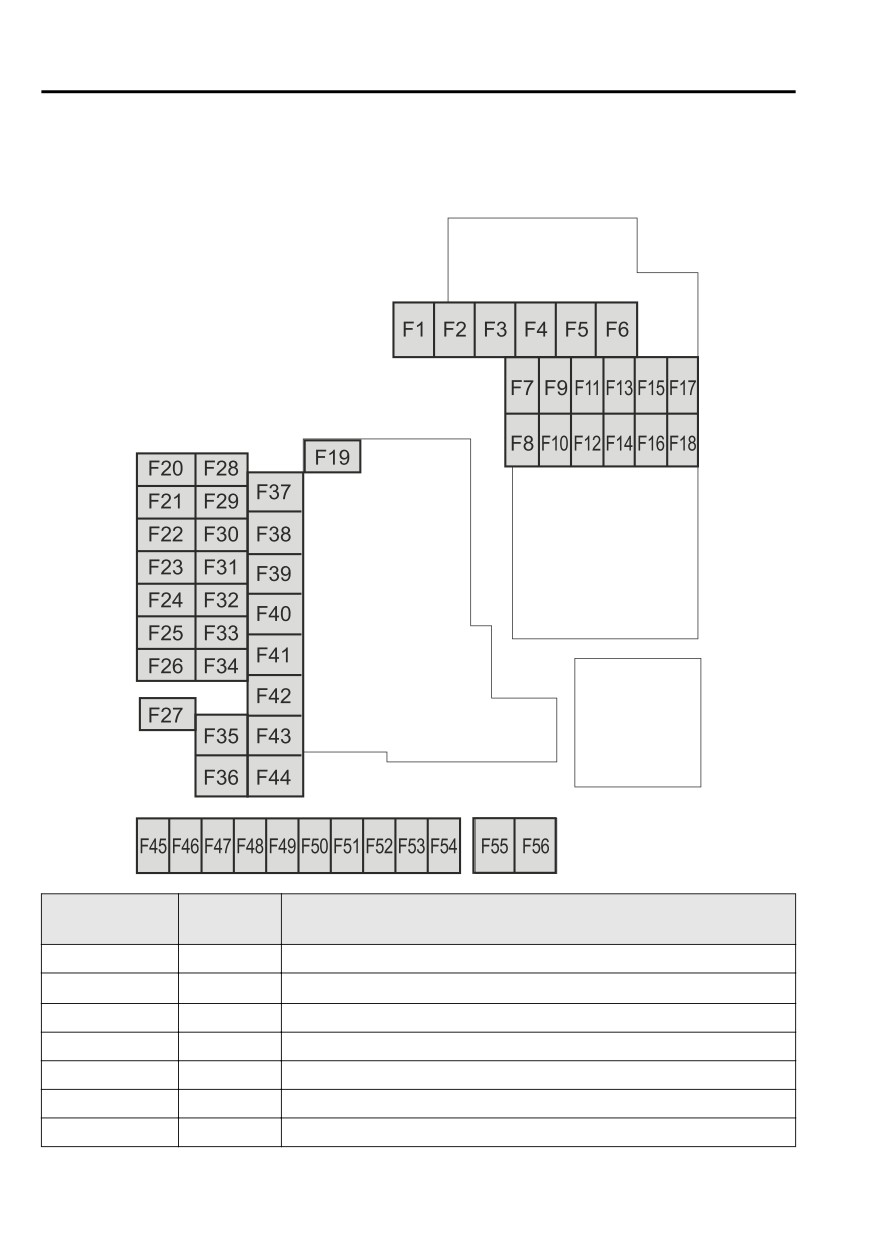
Maintenance and Care
Owner Maintenance
▼ Fuse Panel Description
Fuse block (Engine compartment)
FUSE RAT-
No.
PROTECTED COMPONENT
ING
F1
―
―
F2
20 A
Windshield wiper de-icer*
F3
30 A
Engine control system
F4
20 A
S-VT
F5
40 A
Engine control system
F6
―
―
F7
20 A
Fuel pump
6-38
*Some models.

Maintenance and Care
Owner Maintenance
FUSE RAT-
No.
PROTECTED COMPONENT
ING
F8
15 A
Engine control system
F9
15 A
Transmission control system
F10
10 A
Engine control system
F11
7.5 A
Air conditioner
F12
15 A
Engine control system
F13
―
―
F14
15 A
Electric water pump*
F15
―
―
F16
15 A
For protection of various circuits
F17
―
―
F18
15 A
For protection of various circuits
F19
60 A
Power steering system
F20
15 A
Headlight (LH) 1
F21
15 A
Headlight (RH) 1
F22
15 A
Keyless system
F23
30 A
ABS, Dynamic stability control system
F24
15 A
Headlight (LH) 2
F25
15 A
Headlight (RH) 2
F26
7.5 A
On board diagnostics
F27
25 A
For protection of various circuits
F28
25 A
For protection of various circuits
F29
15 A
Windshield washer
F30
15 A
Accessory sockets
F31
15 A
Horn
F32
―
―
F33
―
―
F34
―
―
F35
50A
ABS, Dynamic stability control system
F36
―
―
F37
30 A
Rear window defogger
F38
50 A
For protection of various circuits
F39
―
―
F40
40 A
Air conditioner
*Some models.
6-39

Maintenance and Care
Owner Maintenance
FUSE RAT-
No.
PROTECTED COMPONENT
ING
F41
30 A
Audio*
F42
20 A
Windshield wipers
F43
30 A
Cooling fan*
F44
30 A
Starter
F45
10 A
Engine control system
F46
15 A
Audio
F47
15 A
For protection of various circuits
F48
7.5 A
Air bag
F49
15 A
Instrument cluster
F50
15 A
Room light
F51
15 A
Panorama sunroof*
F52
15 A
Panorama sunroof*
F53
15 A
Engine control system
F54
15 A
i-ACTIVSENSE
F55
50 A
For protection of various circuits
F56
―
―
6-40
*Some models.

Maintenance and Care
Owner Maintenance
Fuse block (Left side)
FUSE RAT-
No.
PROTECTED COMPONENT
ING
F1
―
―
F2
―
―
F3
20 A
Front seat warmer*
F4
15 A
Power door locks (Driver)
F5
15 A
Power door locks (Passenger)
F6
20 A
Rear seat warmer*
F7
25 A
Power liftgate*
F8
30 A
Power seat (Passenger)*
F9
30 A
Power windows (Driver)
F10
30 A
Power windows (Passenger)
F11
30 A
Power seat (Driver)*
F12
―
―
F13
15 A
Audio
F14
25 A
Audio
F15
15 A
Liftgate lock
*Some models.
6-41
Большое спасибо!
Ваше мнение очень важно для нас.

Нет комментариевНе стесняйтесь поделиться с нами вашим ценным мнением.
Текст